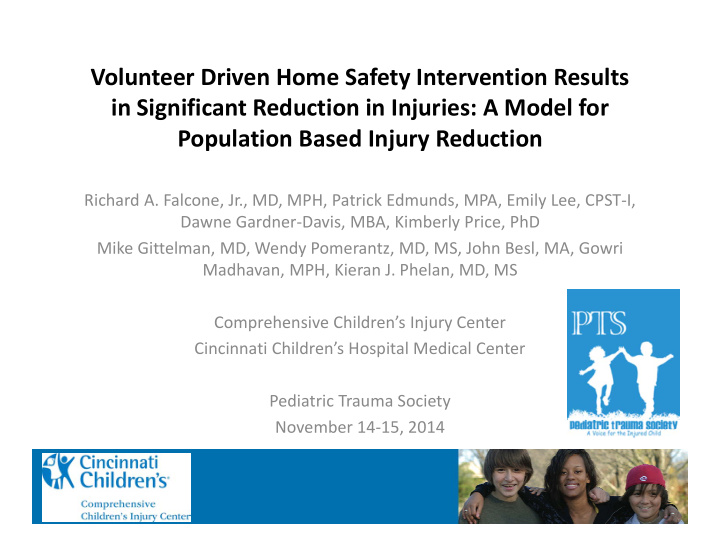



Volunteer Driven Home Safety Intervention Results in Significant Reduction in Injuries: A Model for Population Based Injury Reduction Richard A. Falcone, Jr., MD, MPH, Patrick Edmunds, MPA, Emily Lee, CPST-I, Dawne Gardner-Davis, MBA, Kimberly Price, PhD Mike Gittelman, MD, Wendy Pomerantz, MD, MS, John Besl, MA, Gowri Madhavan, MPH, Kieran J. Phelan, MD, MS Comprehensive Children’s Injury Center Cincinnati Children’s Hospital Medical Center Pediatric Trauma Society November 14-15, 2014
Disclosures • I have no relevant financial relationships with the manufacturer(s) of any commercial product(s) and/or provider(s) of commercial services discussed in this CME activity • I do not intend to discuss an unapproved/ investigative use of a commercial product/device in my presentation • This work was funded in part by Kohl’s for Kids
Background • Despite a 25% reduction over the past two decades the home is the leading location of injury for children under the age of 5 years old • Home based injuries annually result in: – 13 million outpatient visits – 4 million emergency room visits – 2,800 deaths
Home Safety Interventions Work • Face to face education • Injury reduction of up to 70% for modifiable • Provision of safety medically-attended equipment injuries • Delivery in the home Phelan, K, et.al. Arch Ped & Adol Med April, 2011 Kendrick, D, et al. Cochrane Database of Systematic Reviews, 2012
Purpose • Evaluate the impact of a community based volunteer implemented home safety intervention • Hypothesis: Community volunteers, trained on the day of intervention, could provide a home safety bundle within a high risk community resulting in a reduction of emergency room attended injuries.
Hamilton County Specific Data 19,236 injuries a year 178,204 children 0-16 years old 108/1000 children Hamilton County Injury Surveillance System (2010); US Census 2010
The Initial Target • Population – Children aged 1-5 years old • Account for 24% of the population 0-16 (@ 43,000/178,000) • Over 5,500 injury related ED visits a year in HC – Injuries occurring in the home – Cost CCHMC Health Insurance Claims Database 6/17/2011 Average Injury Claims Injury Claims Mean Injury Year of Number of Total ED Net Injury (% Total ED Per 100 Age 0-5 Payment Per Service Members Age Claims Payment Claims) Members Claim 0-5 2007 1851 412 160 (38.8) 8.64 $72,565 $454 2008 2009 527 183 (34.7) 9.11 $95,125 $520 2009 2255 779 252 (32.3) 11.18 $148,080 $588 2010 2461 649 249 (38.4) 10.12 $145,094 $583 Source: CCHMC HR Claims Database. Analysis by Kieran Phelan, Jon Besl, Jane Khoury, Michael Stuart, Shaun Inman
• 832 homes with 1,150 children aged 1-5 years old • 30% of children living below the poverty level 92% of injured children • seeking emergency care presenting to CCHMC • 11.3/1000 injuries per month compared to county baseline of 8.7/1000
The initial location Norwood, OH • 3 square miles (population of 19,200) • Incorporated in 1888 • Old Neighborhood – Old housing stock – Shifting from blue-collar factories to office parks • Local Government to Partner – Mayor, Council, Health Dept., Fire Dept., and Schools • Abundance of Leaders/Organizations – Norwood Service League, Every Child Succeeds, HIPPY, YMCA, Family & Children First, Religious Council
Preventing Injuries in Norwood (PIN) A partnership between the community and Cincinnati Children’s
Home Safety Bundle Equipment Education • Child home safety guide book • CO detector • Magnet list of emergency • Smoke detector numbers Pressure mounted safety gate • General safety • • Swivel mounted outlet covers • Kitchen safety • Cabinet/drawer locks • Bathroom safety • Window locks • Living room safety • Bathtub thermometer • Child bedroom safety Non-slip bathtub stickers • • Bathtub spout cover • Nightlight
Safety Day!
Safety Day • 2-3 events annually • Organized by PIN team with CCHMC Injury Prevention • Family Recruitment • Volunteer Recruitment • Two volunteers per home – One volunteer as educator – One volunteer as installer • 8am – 12pm • Concluding with volunteer lunch and debrief
Key Community Partners
Results • Five Home Safety Days from May 2012-May 2014 • 207 homes received the bundle (25% of homes in Norwood) • Additional 157 homes outside the initial target also received the bundle • 185 volunteer participated
Results • 7-60% family cancellation rate – Too early in day – Did not want volunteers entering the home – Forgot they had signed up – Too busy on day of intervention • < 20% volunteer no-show
Results
Results • 59% reduction in expected injuries in intervention group • 6% increase in non- intervention homes * * *p<0.05
Limitations • Families were self-selected • Family cancelation rates • Volunteer retention • Consistency of bundle implementation • Quality of family tracking and injury data
Conclusions • Volunteer implemented home safety program can result in injury reductions approaching that of interventions by trained experts • Spread of this intervention may lead to a significant shift in the population level injury rates
Thank You!
Recommend
More recommend